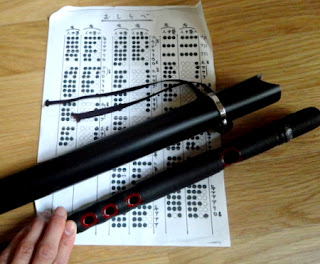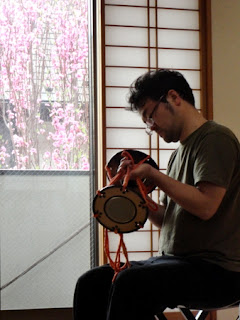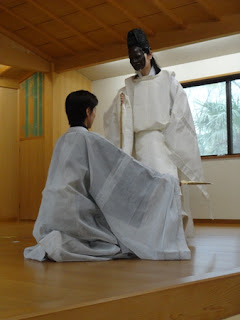At the Kita school 'normal noh' monthly performance on Sunday, I was, again, like last month, low on pencils. But I didn't think it would matter much because this time, I had homework - to
listen carefully to the music and make notes on my own copy of the actual score. This is just one of several pages I have to know off by heart by the beginning of July, for a production of
Atsumori in the US...
...so I had plenty to keep me busy. But even so, my fingers started to itch. I couldn't resist. I got my pen out and...
Here are the grass-cutters, one of whom is actually the disguised ghost of the famously beautiful teenage warrior-musician Atsumori, who was killed by Genji warrior Kumagai on his way to fetch his flute during the battle of Ichi no Tani. The grass-cutters are talking to Kumagai himself, who has become a priest and renamed himself 'Rensho' in remorse after killing Atsumori:
Everyone is amazed when, in the second half of the play, Atsumori's ghost actually appears, admits who he is, and in a series of dances, describes his death...
Then, Rensho wakes up. His conscience is lightened by his prayers for Atsumori's soul, and Atsumori's forgiveness.
This story, from Vol. 9 of
The Tale of the Heike, is told in different ways all over the Japanese traditional arts. The Kabuki
Ichi no Tani Futaba Gunki concentrates on Kumagai/Rensho's remorse and moral punishment - but the noh concentrates on the moment of clarity that enlightenment brings to both Kumagai/Rensho, and, from the afterlife, Atsumori. It is (rightly, in my opinion) one of the most famous plays in the noh repertory.
Hyakuman, the next play on the program, is a 'mad woman' noh play. Instead of featuring a separate ghost, the woman herself is haunted: this play is a lingering portrayal of a woman's grief at the loss of her son. The shape on the right was the enduring image of the play for me: a kimono sleeve raised up to the face in the stylised noh expression for inconsolable sadness
followed by a whirling dance and a
tachimawari (walk around the stage) so poised and intense that it's easy to get swept away into the woman's desolation
Thankfully, these plays usually have happy endings: in
Hyakuman, the woman is reunited with her son (who had been onstage all along sitting behind the priest). Phew!
Grief was the subject of the final play of the day, too.
Tenko, the story of a miraculous drummer boy who was drowned in a river for disobeying the Chinese emperor's orders. Tenko's father is the main character in the first half: aged by grief, he is asked to play his son's drum and eventually does so. The sound of the drum plunges everyone into a dream world where Tenko's ghost appears and, delighted that people are praying for his soul, plays the drum once more.
Tenko is a strange play (for a start it's very unusual and oddly disorienting for the main character to change from an old man to a child's ghost half way through) and also on a grander scale than usual - international setting, large-ish cast. For this, I needed to (try to) get the whole stage in
But the play was long, and my hand got rather clumsy.
Perhaps this time I'll remember to bring not just pencils, but a much-needed eraser, too.

















































